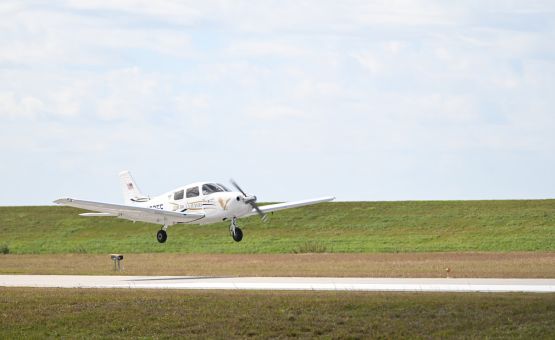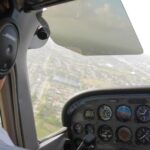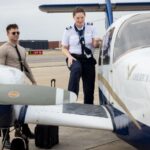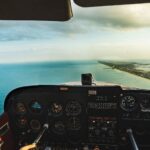TO MAKE CONSISTENTLY GOOD LANDINGS, YOU NEED TO APPLY CONSISTENTLY GOOD PRACTICES.
That is easier said than done, especially for less experienced pilots. It’s difficult because there are many variables to address during the landing process, such as airspeed, power, pitch, wind speed and direction, glide path, configuration, runway alignment, and more. If all a pilot does is react to these ever-changing conditions without employing basic controlling principles, every landing becomes a new experience. Nothing from these landings carries over to the next, so one can never really improve their skills. Yet, this is exactly what many pilots do, always fighting what is happening with the hope that they will somehow wrestle the airplane into submission for a safe touchdown. In this scenario, the pilot is constantly behind the airplane, trying to force rapidly changing parameters back into place. It would be much like the saying “herding cats.”
To begin building the necessary good practices, each landing needs to be divided into segments with specific goals for each segment. Doing this will allow the pilot to concentrate on only what is necessary during that particular phase without worrying about controlling something that does not yet need to be controlled.
The goal of the approach segment is to arrive over the threshold at the right altitude, attitude, airspeed, power setting, configuration, and alignment, ready to begin the round-out and flare. The approach must be stabilized throughout its duration. A stabilized approach means the pitch attitude, airspeed, and power setting are all correct and constant. If, at any time during the approach segment, one of these “correct and constant” parts is lost, a go-around should be initiated.
Surprisingly, bad landings are too often the result of being overly fixated on the airspeed indicator. If the airspeed is the main focus, it will inevitably lead to inappropriately large pitch changes in trying to keep the airspeed at the desired value. In other words, overcontrolling occurs. The airspeed indicator is a performance instrument, not a control instrument. That means it only provides information on aircraft performance, but because of the delays in updating that information, it cannot be used to make control inputs. As strange as it might sound, you cannot control airspeed by focusing on the airspeed indicator because it can’t tell you how much pitch and/or power change is necessary to achieve the desired airspeed.
To make consistently good landings, it’s critical to understand the relationship between pitch, power, and performance. The key is to establish and maintain the desired descent sight picture while maintaining the desired power setting. In doing so, you will avoid the roller coaster effect of overcontrolling, and you’ll discover that the airspeed will be maintained right where it needs to be.
The reality is, you can’t make good landings with your focus in the cockpit, regardless of what instrument you are looking at. Your eyes need to be outside the airplane 90% of the time. Pitch changes are more easily detected and controlled by focusing on the sight picture out of the windshield. Once again, if pitch and power are controlled, airspeed will be controlled with only an occasional glance at the airspeed indicator to determine if pitch and power changes are necessary. And if they are, they need to be done with finesse, only making minor changes to avoid overcontrolling. If major changes are called for, so should a go-around.
The round-out and flare segments normally begin when crossing the threshold. The key is to establish the proper outside sight picture and maintain that attitude until touchdown. The flare sight picture is normally achieved by putting the aircraft’s nose on the horizon, or, in other words, the normal climb attitude. Smoothly reducing the power to idle while holding that sight picture should result in a smooth touchdown on the main wheels with minimal adjustments to pitch and power.
The rollout segment is continued by holding the nose off the ground until the airplane slows enough for the nosewheel to gently touch down. It’s also important that any crosswind correction needed during the approach be held throughout the rollout while actually increasing the aileron deflection as the speed decreases. Remember that just because the wheels have touched down, the airplane is not finished flying, and positive control will still be required during the rollout.
During the landing process, minor corrections will need to be made. Again, it’s all about pitch and power control. Both pitch and power need to be adjusted to correct deviations from the desired norm. Minor deviations, especially during the flare, must be made by making appropriate changes to the desired flare sight picture and the needed power setting. Above all, avoid overcontrolling, which is the enemy of a good landing.
Another important factor is understanding where the eyes should look during the landing process. During the approach segment, attention should be on the aim point to determine where touchdown will occur so that needed adjustments can be made. Then, as the runway threshold is approached and the flare begins, the eyes need to transition further down the runway to obtain a more accurate sense of the rate of descent and the height above the runway, much as a parachute jumper looks towards the horizon to gauge when he needs to be ready to “touchdown.” If this change of focus down the runway is not made, a sense of “ground rush” will occur, most likely resulting in a quick pitch-up and ballooning to follow.
As the nose is raised during the flair, it will become necessary to adjust vision to the bottom corner of the windscreen to ensure runway alignment is maintained. Many pilots touch down far too flat and, consequently, too fast because they do not want to lose sight of the runway over the nose of the airplane. Thus, they never raise the nose high enough for a proper touchdown attitude on the main gear. As a result, they fly the airplane onto the runway rather than landing on the runway.
Learning how to properly control pitch and power during the landing process, rather than just chasing airspeed, will make the landing process far less stressful and introduce a level of consistency that will inspire confidence in your ability to land an airplane.










